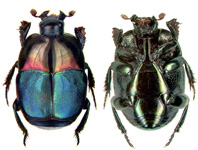Abstract
Identification of nematode species by using conventional methods requires fixation of the isolated material and a suitable preparation for further analyses. Tentative identification using microscopic methods should also be performed prior to initiating molecular studies. In the literature, various methods are described for the preparation of nematodes from the genus Aphelenchoides for identification and microscopic studies. The most commonly used fixatives are formalin (Timm 1969; Szczygieł & Cid del Prado Vera 1981, Crozzoli et al. 2008, Khan et al. 2008), FAA (Wasilewska 1969; Vovlas et al. 2005, Khan et al. 2007) and TAF (Hooper 1958, Chizhov et al. 2006, Jagdale & Grewal 2006).
References
Brown, D.J.F. & Topham, P.B. (1984) A comparison of reported variation in the morphometrics of Xiphinema diversicaudatum (Nematoda: Dorylaimida) and the effects of some methods of reparing specimens for examination by optical microscopy. Nematologia Meditteranea, 12, 169–186.
Chizhov, V.N., Chumakova, O.A., Subbotin, S.A. & Baldwin, J.G. (2006) Morphological and molecular characterization of foliar nematodes of the genus Aphelenchoides: A. fragariae and A. ritzemabosi (Nematoda: Aphelenchoididae) from the Main Botanical Garden of Russian Academy of Science, Moscow. Russian Journal of Nematology, 14 (2), 179–184.
Courtney, W.D., Polley, D. & Miller, V.L. (1955) TAF, an improved fixative in nematode technique. Plant Disease Reporter, 39, 570–571.
Crozzoli, R., Hurtado, T., Perichi, G. & Arcia, A. (2008) Characterization of a Venezuelan population of Aphelenchoides ritzemabosi on chrysanthemum. Nematologia Meditteranea, 36, 79–83.
Dobosz, R., Winiszewska, G., Malewski, T., Rybarczyk-Mydłowska, K., Tereba, A., Kowalewska, K., Gawlak, M. & Bogdanowicz, W. (2013) Morphological and molecular features of Punctodera stonei Brzeski, 1998 (Nematoda: Heteroderidae) – species associated with roots of grasses. Annales Zoologici, 63, 157–162.
http://dx.doi.org/10.3161/000345413X669487Grewal, P.S., Richardson, P.N. & Wright, D.J. (1990) Effects of killing, fixing and mounting methods on taxonomic characters of parthenogenetic adult female Caenorhabditis elegans (Nematoda: Rhabditidae). Revue de Nématologie, 13 (4), 437–444.
Hooper, D.J. (1958) Aphelenchoides dactylocercus n. sp. and A. sacchari n. sp. (Nematoda: Aphelenchoidea). Nematologica, 3, 229–235.
http://dx.doi.org/10.1163/187529258X00454Jagdale, G.B. & Grewal, P.S. (2006) Infection behaviour and overwintering survival of foliar nematodes, Aphelenchoides fragariae, on Hosta. Journal of Nematology, 38 (1), 130–136.
Jiang, L., Li, X. & Zheng, J. (2007) First record of Bursaphelenchus rainulfi on pine trees from eastern China and its phylogenetic relationship with intro-genus species. Journal of Zheijang University SCIENCE B, 8 (5), 345–351.
http://dx.doi.org/10.1631/jzus.2007.B0345Khan, M.R., Handoo, Z.A., Rao, U., Rao, S.B. & Prasad, J.S. (2012) Observations on the foliar nematode, Aphelenchoides besseyi, infecting Tuberose and Rice in India. Journal of Nematology, 44 (4), 391–398.
Khan, Z., Son, S.H., Moon, H.S., Kim, S.G., Shin, H.D., Jeon, Y.H. & Kim, Y.H. (2007) Description of foliar nematode, Aphelenchoides fragariae (Nematoda: Aphelenchida) with additional characteristics from Korea. Journal of Asia-Pacific Entomology, 10 (4), 313–315.
http://dx.doi.org/10.1016/S1226-8615(08)60368-4Khan, Z., Son, S.H., Shin, H.D. & Kim, Y.H. (2008) First report of a foliar nematode Aphelenchoides fragariae (Aphelenchidae) on Stachys riederi var. japonica, a medicinal plant, in Korea. Plant Pathology Journal, 24 (1), 97–100.
http://dx.doi.org/10.5423/PPJ.2008.24.1.097Lamberti, F. & Sher, S.A. (1969) A Comparison of preparation techniques in taxonomic studies of Longidorus africanus Merny. Journal of Nematology, 1 (3), 193–200.
Luc, M., Sikora, R.A. & Bridge, J. (2005) Plant Parasitic Nematodes in Subtropical and Tropical Agriculture, CABI, 871 pp.
http://dx.doi.org/10.1079/9780851997278.0000Naem, S., Pagan, C. & Nadler, S.A. (2010) Structural restoration of nematodes and acanthocephalans fixed in high percentage alcohol using DESS solution and rehydration. Journal of Parasitology, 96 (4), 809–811.
http://dx.doi.org/10.1645/GE-2402.1Schwartz, M. (1911) Die Aphelenchen der Veilchengallen und der Blattflecken an Farnen und Chrysanthemum. Arbeiten aus der Kaiserlichen Biologischen Anstalt für Land- und Forstwirtschaft, 8, 303–344.
Seinhorst, J.W. (1962) On the killing, fixation and transferring to glycerin of nematodes. Nematologica, 8 (1), 29–32.
http://dx.doi.org/10.1163/187529262X00981Seinhorst, J.W. (1966) Killing nematodes for taxonomic study with hot F.A. 4:1. Nematologica, 12 (1), 178.
http://dx.doi.org/10.1163/187529266x00239Steiner, G. & Buhrer, E.M. (1932) Miscellaneous notes on nemic diseases. Plant Disease Reporter, 16, 137.
Strona, G., Stefani, F. & Galli, P. (2009) Field preservation of monogenean parasites for molecular and morphological analyses. Parasitology International, 58, 51–54.
http://dx.doi.org/10.1016/j.parint.2008.10.001Szczygieł A. & Cid del Prado Vera, I. (1981) Association of Aphelenchoides fragariae and A. ritzemabosi with strawberry plants in Mexico. Zeszyty Problemowe Postępów Nauk Rolniczych, 249, 81–85.
Tamura, K., Peterson, D., Peterson, N., Stecher, G., Nei, M. & Kumar, S. (2011) MEGA5: Molecular evolutionary genetics analysis using maximum likelihood, evolutionary distance and maximum parsimony methods. Molecular Biology and Evolution, 28, 2731–2739.
http://dx.doi.org/10.1093/molbev/msr121Timm, R.W. (1969) Two marine species of Aphelenchoides. Nematologica, 15, 370–375.
http://dx.doi.org/10.1163/187529269X00434Vovlas, N., Minuto, A., Garibaldi, A., Troccoli, A. & Lamberti, F. (2005) Identification and histopathology of the foliar nematode Aphelenchoides ritzemabosi (Nematoda: Aphelenchoididae) on basil in Italy. Nematology, 7 (2), 301–308.
http://dx.doi.org/10.1163/1568541054879548Wasilewska, L. (1969) Aphelenchoides dubius sp. n. from Poland (Nematoda, Aphelenchoidea). Bulletin de L'Academie Polonaise des Sciences, Série des Sciences Biologiques, 17 (7), 455–458.
Yoder, M., Tandingan De Ley, I., King, I.W., Mundo-Ocampo, M., Mann, J., Blaxter, M., Potras, L. & De Ley, P. (2006) DESS: a versatile solution for preserving morphology and extractable DNA of nematodes. Nematology, 8 (3), 367–376.
http://dx.doi.org/10.1163/156854106778493448

